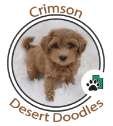Vaccination
It is very important to not expose your new puppy to other dogs or humans not living with you. Do not take them outside for walks or park time, where they could be exposed to parvo and other illnesses until all shots have been given.
First Night Home
Start the puppy off in its crate the first night. Make sure the puppy has not had water after 4 p.m., that the puppy had its supper, and has been given a chance to relieve itself just before you go to bed. Put the crate with a towel in it next to your bed. Put the puppy in the crate with a puppy biscuit, always reward for entering the crate, and settle down for the night.
If the puppy has other ideas, do not give in. Do not take the puppy on the bed or allow the puppy to run free in the bedroom. The first couple of nights are the most important to both you and the puppy. Training is a matter of patience and time.
Reward– Always reward for correct behavior, even if it’s only a small cracker. Carry some in your pocket for any occasion such as crating, performance of housebreaking duties, and coming when called. The opportunities are boundless and will be a shortcut to training your puppy quickly and happily.
Grooming Care
Your new puppy has been delivered to you freshly bathed, toe nails trimmed, hair in the ear canal has been removed, and ears are fresh and clean smelling.
Basics of Coat Care
Prior to being bathed, your puppy should be brushed out thoroughly. Ideally, the puppy should be bathed (using a mild puppy shampoo) at least twice a month. Care must be taken not to allow any soap in puppy’s eyes or water it its ears.
Blow dry your puppy under low heat from your hair dryer, using the brush while blowing dry.
It’s better to use a pin brush, rather than a wire slicker, which is meant for badly tangled coats and will pull out hair.
It is a good idea to brush your puppy every other day or so, which will ensure that you never have to worry about its coat becoming tangled and matted. If this does happen the coat may have to be shaved completely, something you want to avoid.
If you don’t want to bathe your puppy at home, it may be done by a professional groomer in a grooming shop. It is not wise to expose your puppy to the grooming shop until after 16 weeks, when shots for parvo and distemper will be fully up to date.
Clipping and scissoring should be left to the professional at the start, however, many people learn to do their own trimming in time and enjoy the challenge.
Ears should be cleaned weekly. Gently pull the long hairs out of the ear canal regularly, and swab the ear with your finger wrapped in cotton moistened with ear cleaner recommended by your vet or groomer. If the puppy is scratching its ears or the ears have a bad odor see your vet immediately.
Toenails must be clipped every week or two. This is very important. By doing the nails regularly the puppy will become used to it. Take off only the tip ends of the nail, as you do not want to cut into the “Quick,” which will hurt and bleed.
Whatever you do in terms of grooming do not frighten the puppy or make it nervous about grooming. Teach it to lie quietly as it is being brushed, and rely on treats to make it an enjoyable experience.
Crate Training
A crate is not a jail; it is the safest place the puppy can be to learn to be housebroken, have its meals, sleep at night, ride in the car, and stay in hotels and motels. It will become its own portable “Den.” The nature of a dog is not to foul its Nest. This means that until you have instilled in the puppy an idea of housebreaking, a healthy puppy will not go against its natural instincts.
Have a crate the size that will fit the puppy comfortably, large enough so that the puppy may stand up, turn around, and has enough space to lie down with ease. You may have to get a larger crate as the puppy grows. If your crate is larger than your puppy’s needs and comes with a divider you can install the divider and remove it once the puppy has grown. If the puppy is going to be large, do not buy a huge crate to begin with. It will give the puppy ideas of being able to use a portion of it as a restroom, something you do not want to happen.
Travel– Always travel with your puppy in its crate; it is the only safe way.
